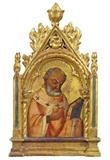Biagio di Giorgio da Traù
(Trogir or Lapac circa 1390–1450 Zadar)
Saint Nicholas (?),
tempera on gold ground panel, shaped, 44.5 x 28 cm (including frame), in an engaged frame
Provenance:
Private collection, Sicily
Literature:
Z. Demori-Stanicˇi´c, in: Biagio di Giorgio da Traù, 1375 c. – 1450, exhibition catalogue, Zagreb 1989, pp. 112-114, mentioned under no. 13 (illustrated as part of a polyptych)
The two panels (lots 4 and 5) were once part of a polyptych which is conserved in the Diocese Museum of Sebenico (see literature). In its present form, the altarpiece consists of a central panel that is larger than the rest, which represents the Madonna and Child, while the smaller lateral panels contain Saint Peter, Saint Michael, Saint Stephen, and Saint James each with their respective attributes. The upper section of the polyptych, which was dismembered at an unknown date, represented according to the photographic evidence, a Crucifixion with Mary and Saint John in the three panels above the larger central panel, and at each side, two unidentified female saints. The farthest-most lateral panels represented the Angel of the annunciation and Mary annunciate, while placed between these, and the three central panels, were the two panels under discussion here.
The two saints shown here are represented half-length, one may be identifiable as Saint Nicholas while the other shown wearing a monastic habit is unidentified, both are enclosed within richly carved and ornamented frame. The polyptych, and therefore also the present panels, have been dated to the artist’s maturity, towards the 1430s (see literature).
Biagio di Giorgio da Traù was active in various centres on the Dalmatian coast including Split, Traù, Ragusa and Zara. His works reveal a knowledge of the artistic innovations that occurred in Venice, particularly during the 1410s when Gentile da Fabriano and Jacobello del Fiore were present, suggesting that Biagio di Giorgio received his training there (see A. De Marchi, La mostra di Biagio di Giorgio da Traù a Venezia, in: Arte Veneta, XLIII, 1989-1990, p. 178). However, his pictorial language also show the refinements of the international gothic as well as certain traits such as the intensely expressive features of his male figure types, such as those of the two present Saints and in the polyptych with Saint James and Saints at Traù.
View it on
Estimate
Time, Location
Auction House
(Trogir or Lapac circa 1390–1450 Zadar)
Saint Nicholas (?),
tempera on gold ground panel, shaped, 44.5 x 28 cm (including frame), in an engaged frame
Provenance:
Private collection, Sicily
Literature:
Z. Demori-Stanicˇi´c, in: Biagio di Giorgio da Traù, 1375 c. – 1450, exhibition catalogue, Zagreb 1989, pp. 112-114, mentioned under no. 13 (illustrated as part of a polyptych)
The two panels (lots 4 and 5) were once part of a polyptych which is conserved in the Diocese Museum of Sebenico (see literature). In its present form, the altarpiece consists of a central panel that is larger than the rest, which represents the Madonna and Child, while the smaller lateral panels contain Saint Peter, Saint Michael, Saint Stephen, and Saint James each with their respective attributes. The upper section of the polyptych, which was dismembered at an unknown date, represented according to the photographic evidence, a Crucifixion with Mary and Saint John in the three panels above the larger central panel, and at each side, two unidentified female saints. The farthest-most lateral panels represented the Angel of the annunciation and Mary annunciate, while placed between these, and the three central panels, were the two panels under discussion here.
The two saints shown here are represented half-length, one may be identifiable as Saint Nicholas while the other shown wearing a monastic habit is unidentified, both are enclosed within richly carved and ornamented frame. The polyptych, and therefore also the present panels, have been dated to the artist’s maturity, towards the 1430s (see literature).
Biagio di Giorgio da Traù was active in various centres on the Dalmatian coast including Split, Traù, Ragusa and Zara. His works reveal a knowledge of the artistic innovations that occurred in Venice, particularly during the 1410s when Gentile da Fabriano and Jacobello del Fiore were present, suggesting that Biagio di Giorgio received his training there (see A. De Marchi, La mostra di Biagio di Giorgio da Traù a Venezia, in: Arte Veneta, XLIII, 1989-1990, p. 178). However, his pictorial language also show the refinements of the international gothic as well as certain traits such as the intensely expressive features of his male figure types, such as those of the two present Saints and in the polyptych with Saint James and Saints at Traù.



